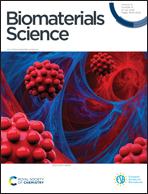Retracted Article: Cytocompatible, soft and thick brush-modified scaffolds with prolonged antibacterial effect to mitigate wound infections†
Abstract
Biomedical device or implant-associated infections caused by pathogenic bacteria are a major clinical issue, and their prevention and/or treatment remains a challenging task. Infection-resistant antimicrobial coatings with impressive cytocompatibility offer a step towards addressing this problem. Herein, we report a new strategy for constructing highly antibacterial as well as cytocompatible mixed polymer brushes onto the surface of 3D printed scaffold made of biodegradable tartaric acid-based aliphatic polyester blends. The mixed brushes were nothing but a combination of poly(3-dimethyl-(methacryloyloxyethyl) ammonium propane sulfonate) (polyDMAPS) and poly((oligo ethylene glycol) methyl ether methacrylate) (polyPEGMA) with varying chain length (n) of the ethylene glycol unit (n = 1, 6, 11, and 21). Both homo and copolymeric brushes of polyDMAPS with polyPEGMA exhibited antibacterial efficacy against both Gram positive and Gram negative pathogens such as E. coli (Escherichia coli) and S. aureus (Staphylococcus aureus) because of the combined action of bacteriostatic effects originating from strongly hydrated layers present in zwitterionic (polyDMAPS) and hydrophilic (polyPEGMA) copolymer brushes. Interestingly, a mixed polymer brush comprising polyDMAPS and polyPEGMA (ethylene glycol chain unit of 21) at 50/50 ratio provided zero bacterial growth and almost 100% cytocompatibility (tested using L929 mouse fibroblast cells), making the brush-modified biodegradable substrate an excellent choice for an infection-resistant and cytocompatible surface. An attempt was made to understand their extraordinary performance with the help of contact angle, surface charge analysis and nanoindentation study, which revealed the formation of a hydrophilic, almost neutral, very soft surface (99.99% reduction in hardness and modulus) after modification with the mixed brushes. This may completely suppress bacterial adhesion. Animal studies demonstrated that these brush-modified scaffolds are biocompatible and can mitigate wound infections. Overall, this study shows that the fascinating combination of an infection-resistant and cytocompatible surface can be generated on biodegradable polymeric surfaces by modulating the surface hardness, flexibility and hydrophilicity by selecting appropriate functionality of the copolymeric brushes grafted onto them, making them ideal non-leaching, anti-infective, hemocompatible and cytocompatible coatings for biodegradable implants.



 Please wait while we load your content...
Please wait while we load your content...